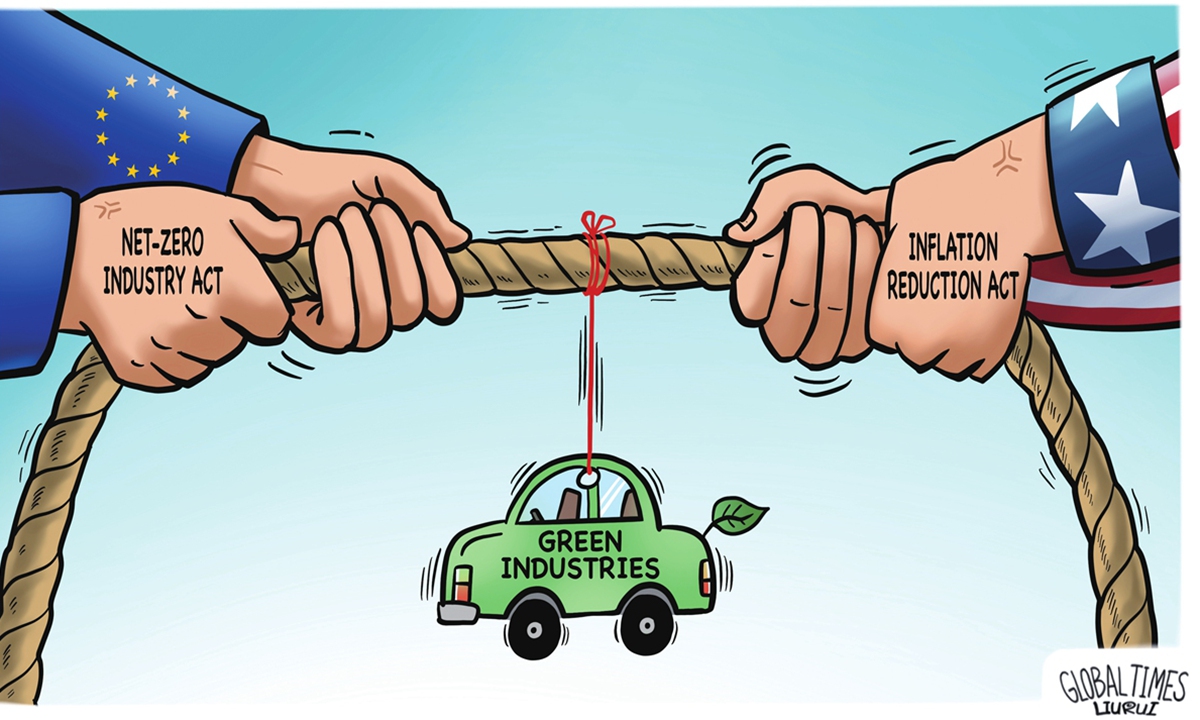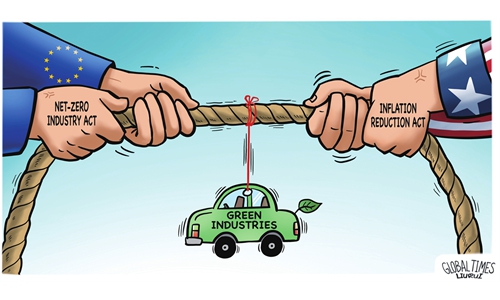
Illustration:Liu Rui/GT
The EU is planning to hit back at the US' Inflation Reduction Act by easing restrictions to allow a wave of tax credits for green investment, reports show. EU members have been vigilant toward the Inflation Reduction Act ever since it was unveiled. The next question is, where will the EU's own version of the Act go?
There are three obvious characteristics of the EU's counter proposal. First, it is a direct hit back against the US. Second, it is a passive countermove by the EU. Third, it can be expected to be resilient.
EU's plan to relax state-aid rules to support investment in green sectors is similar to that of the US. On the surface, it looks like an approach to cut inflation, but it is in fact a competition in new-energy sector between the EU and the US. At first, the US' act was aimed at China. However, the EU soon realized its interests in new-energy vehicles would be severely hurt. So before other countries were able to react, it stood up to confront the US. Yet, the move is still passive.
Although being a passive reaction, the EU's version of Inflation Reduction Act can still have strong resilience after it is introduced.
The EU has a huge market size and cultural traditions for new-energy vehicles and green industries. In addition, the purchasing power of the EU, including Western Europe, the Nordic countries, Southern European countries and some Central European countries, is not weak compared to American consumers.
The EU's green and environmental protection industry market is far ahead of that of the North American region. People in European countries have adhered to the concept of green development and environmental protection for decades and put it into practice in a pragmatic manner. Although North America has made progress in the field of green and environmental protection in recent years, there is still a certain gap with the EU.
The EU also has three shortcomings. First, the technology of the EU new-energy automobile industry is still far behind and catching up with that of the US and China; second, in terms of investment in new-energy automobile and green industry, the EU has not yet been able to match the US and China; third, the EU is still a partnership among sovereign states, with a relatively loose structure and low negotiation efficiency.
However, if these three shortcomings are handled properly and coupled with structural reform measures, the EU has an opportunity to find a new and effective path. Although the EU does not have the technological advantage of new energy, this can be hedged by its huge market size and purchasing power. The political structure of the EU is also moving forward step by step, slowly but steadily, and evolving toward a more close and effective structure, or "ever greater union."
However, the EU is in a passive state not only when it comes to the Inflation Reduction Act, but also in many other areas, the infrastructure in particular. Be it the 70 overseas infrastructure projects that the EU plans to launch in the near future, or the EU's plan to invest more than €280 million in grants in South Africa, under the Global Gateway initiative, they all have shown EU's passive state in global development. The problem is rooted in its own political structure and decision-making mechanisms.
In short, in the face of the US' Inflation Reduction Act, it's possible that the EU will make more active counterattacks in the future. Facing a strong offensive by the US; China and the EU, the two major economies, could join hands in new-energy vehicle and green environmental protection industries, so as to jointly lead the world's green and environmental protection trends.
The author is director of the French Economic Research Center and researcher of the Institute of Regional and International Studies at the University of International Business and Economics in Beijing. opinion@globaltimes.com.cn

